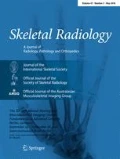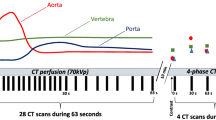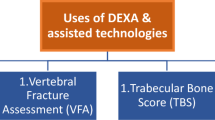Abstract
Objective
The aim was to systematically assess the literature on possible effect of administration of iodinated contrast media on CT-estimated bone mineral density (BMD).
Materials and methods
The Web of Science and PubMed databases were searched. Studies that used both CT principles of BMD measurement (volumetric quantitative BMD and CT attenuation in Hounsfield Units) were included. The baseline patient data, skeletal site, contrast medium data (if reported), and change in BMD on contrast-enhanced CT scans were collected.
Results
Sixteen studies met our review criteria, the majority of which was performed on lumbar spine, and the others on proximal femur. Almost all studies reported a significant increase in BMD values on the contrast-enhanced CT scans, ranging from 0.8 to 30.3%. The increase was most frequently reported to be about 10 to 15% for the spine and 5 to 10% for the femur. In addition to the difference in skeletal site, some authors found the contrast effect was age-, sex-, and contrast dose-dependent. BMD values in arterial phase were generally somewhat lower than in venous phase, and the effect of contrast in venous phase was more predictable.
Conclusion
The review revealed significant changes in BMD values between unenhanced and contrast-enhanced CT. The change was more pronounced in lumbar spine than in proximal femur and appeared to depend on age, sex, contrast dose, and postcontrast imaging protocol. The review suggests the understanding of all mentioned factors during the interpretation of BMD measured on contrast-enhanced CT.

Similar content being viewed by others
References
Delsmann MM, Strahl A, Mühlenfeld M, et al. High prevalence and undertreatment of osteoporosis in elderly patients undergoing total hip arthroplasty. Osteoporos Int. 2021;32:1661–8. https://doi.org/10.1007/s00198-021-05881-y.
Link TM. Osteoporosis imaging: state of the art and advanced imaging. Radiology. 2012;263:3–17. https://doi.org/10.1148/radiol.2631201201.
Choi MK, Kim SM, Lim JK. Diagnostic efficacy of Hounsfield units in spine CT for the assessment of real bone mineral density of degenerative spine: correlation study between T-scores determined by DEXA scan and Hounsfield units from CT. Acta Neurochir [Wien]. 2016;158:1421–7. https://doi.org/10.1007/s00701-016-2821-5.
Alawi M, Begum A, Harraz M, et al. Dual-energy x-ray absorptiometry (DEXA) scan versus computed tomography for bone density assessment. Cureus. 2021;13:e13261. https://doi.org/10.7759/cureus.13261.
Adams JE. Quantitative computed tomography. Eur J Radiol. 2009;71:415–24. https://doi.org/10.1016/j.ejrad.2009.04.074.
Pickhardt PJ, Pooler BD, Lauder T, del Rio AM, Bruce RJ, Binkley N. Opportunistic screening for osteoporosis using abdominal computed tomography scans obtained for other indications. Ann Intern Med. 2013;158:588–95. https://doi.org/10.7326/0003-4819-158-8-201304160-00003.
Schöckel L, Jost G, Seidensticker P, Lengsfeld P, Palkowitsch P, Pietsch H. Developments in x-ray contrast media and the potential impact on computed tomography. Invest Radiol. 2020;55:592–7. https://doi.org/10.1097/RLI.0000000000000696.
Hopper KD, Wang MP, Kunselman AR. The use of clinical CT for baseline bone density assessment. J Comput Assist Tomogr. 2000;24:896–9. https://doi.org/10.1097/00004728-200011000-00015.
Bauer JS, Henning TD, Müeller D, Lu Y, Majumdar S, Link TM. Volumetric quantitative CT of the spine and hip derived from contrast-enhanced MDCT: conversion factors. AJR Am J Roentgenol. 2007;188:1294–301. https://doi.org/10.2214/AJR.06.1006.
Acu K, Scheel M, Issever AS. Time dependency of bone density estimation from computed tomography with intravenous contrast agent administration. Osteoporos Int. 2014;25:535–42. https://doi.org/10.1007/s00198-013-2440-4.
Pickhardt PJ, Lauder T, Pooler BD, et al. Effect of IV contrast on lumbar trabecular attenuation at routine abdominal CT: correlation with DXA and implications for opportunistic osteoporosis screening. Osteoporos Int. 2016;27:147–52. https://doi.org/10.1007/s00198-015-3224-9.
Pompe E, Willemink MJ, Dijkhuis GR, Verhaar HJ, Mohamed Hoesein FA, de Jong PA. Intravenous contrast injection significantly affects bone mineral density measured on CT. Eur Radiol. 2015;25:283–9. https://doi.org/10.1007/s00330-014-3408-2.
Boutin RD, Kaptuch JM, Bateni CP, Chalfant JS, Yao L. Influence of IV contrast administration on CT measures of muscle and bone attenuation: implications for sarcopenia and osteoporosis evaluation. AJR Am J Roentgenol. 2016;207:1046–54. https://doi.org/10.2214/AJR.16.16387.
Islamian JP, Garoosi I, Abdollahi Fard K, Abdollahi MR. How much intravenous contrast media affect bone mineral density (BMD) assessed by routine computed tomography (CT). The Egyptian J Radiol Nucl Med. 2016;47:571–5. https://doi.org/10.1016/j.ejrnm.2016.03.012.
Jørgensen HS, Winther S, Bøttcher M, et al. effect of intravenous contrast on volumetric bone mineral density in patients with chronic kidney disease. J Clin Densitom. 2016;19:423–9. https://doi.org/10.1016/j.jocd.2016.04.009.
Ziemlewicz TJ, Maciejewski A, Binkley N, Brett AD, Brown JK, Pickhardt PJ. Direct comparison of unenhanced and contrast-enhanced CT for opportunistic proximal femur bone mineral density measurement: implications for osteoporosis screening. AJR Am J Roentgenol. 2016;206:694–8. https://doi.org/10.2214/AJR.15.15128 (PMID: 26866336).
Abdullayev N, Neuhaus VF, Bratke G, et al. Effects of contrast enhancement on in-body calibrated phantomless bone mineral density measurements in computed tomography. J Clin Densitom. 2018;21:360–6. https://doi.org/10.1016/j.jocd.2017.10.001.
Toelly A, Bardach C, Weber M, et al. Influence of contrast media on bone mineral density (BMD) measurements from routine contrast-enhanced MDCT datasets using a phantom-less bmd measurement tool. Rofo. 2017;189:537–43. https://doi.org/10.1055/s-0043-102941.
Elsayed NM, Esmail MA, Abdulsattar EK. Does intravenous contrast used in computed tomography affect the bone mineral density? Clinical Medicine and Diagnostics. 2018;8:53–8. https://doi.org/10.5923/j.cmd.20180803.03.
Gerety EL, Bearcroft PW. L1 vertebral density on CT is too variable with different scanning protocols to be a useful screening tool for osteoporosis in everyday practice. Br J Radiol. 2018;91:20170395. https://doi.org/10.1259/bjr.20170395.
Lee HW, Ha HI, Park SY, Lim HK. Reliability of 3D image analysis and influence of contrast medium administration on measurement of Hounsfield unit values of the proximal femur. PLoS ONE. 2020;15:e0241012. https://doi.org/10.1371/journal.pone.0241012.
Perez AA, Pickhardt PJ, Elton DC, Sandfort V, Summers RM. Fully automated CT imaging biomarkers of bone, muscle, and fat: correcting for the effect of intravenous contrast. Abdom Radiol (NY). 2021;46:1229–35. https://doi.org/10.1007/s00261-020-02755-5.
Woisetschläger M, Klintström E, Spångeus A. The impact of imaging time and contrast agent dose on screening for osteoporosis with contrast-enhanced CT. Eur Radiol Exp. 2022;6:8. https://doi.org/10.1186/s41747-021-00259-5.
Ratcliffe JF. The arterial anatomy of the adult human lumbar vertebral body: a microarteriographic study. J Anat. 1980;131:57–79 (PMID: 7440404).
Griessenauer CJ, Raborn J, Foreman P, Shoja MM, Loukas M, Tubbs RS. Venous drainage of the spine and spinal cord: a comprehensive review of its history, embryology, anatomy, physiology, and pathology. Clin Anat. 2015;28:75–87. https://doi.org/10.1002/ca.22354.
Lahtinen T, Alhava EM, Karjalainen P, Romppanen T. The effect of age on blood flow in the proximal femur in man. J Nucl Med. 1981;22:966–72 (PMID: 7299482).
Poole KES, Skingle L, Gee AH, et al. Focal osteoporosis defects play a key role in hip fracture. Bone. 2017;94:124–34. https://doi.org/10.1016/j.bone.2016.10.020.
Prisby RD, Ramsey MW, Behnke BJ, et al. Aging reduces skeletal blood flow, endothelium-dependent vasodilation, and NO bioavailability in rats. J Bone Miner Res. 2007;22:1280–8. https://doi.org/10.1359/jbmr.070415.
Author information
Authors and Affiliations
Corresponding author
Ethics declarations
Conflict of interest
The authors declare no competing interests.
Additional information
Publisher's note
Springer Nature remains neutral with regard to jurisdictional claims in published maps and institutional affiliations.
Rights and permissions
Springer Nature or its licensor (e.g. a society or other partner) holds exclusive rights to this article under a publishing agreement with the author(s) or other rightsholder(s); author self-archiving of the accepted manuscript version of this article is solely governed by the terms of such publishing agreement and applicable law.
About this article
Cite this article
Kutleša, Z., Jerković, K., Ordulj, I. et al. The effect of contrast media on CT measures of bone mineral density: a systematic review. Skeletal Radiol 52, 687–694 (2023). https://doi.org/10.1007/s00256-022-04222-2
Received:
Revised:
Accepted:
Published:
Issue Date:
DOI: https://doi.org/10.1007/s00256-022-04222-2




